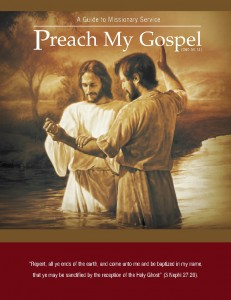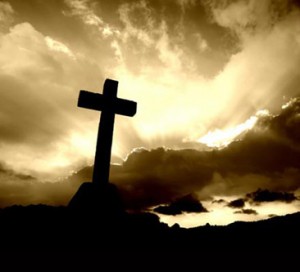 In the early-1950s the Mormon Church taught its missionaries a particular method for effective proselytizing. The book, A Systematic Program for Teaching the Gospel was published and distributed by the LDS Church as detailed instruction for missionaries. I was recently reading Lesson 1, “The Godhead,” and was struck by how the Mormon Church’s missionary approach has changed over the years. In 1955 the first missionary lesson focused on two very specific points: God the Father has a body of flesh and bones plus spirit; and the investigator’s church (and all “churches of the world”) teach a false concept of God.
In the early-1950s the Mormon Church taught its missionaries a particular method for effective proselytizing. The book, A Systematic Program for Teaching the Gospel was published and distributed by the LDS Church as detailed instruction for missionaries. I was recently reading Lesson 1, “The Godhead,” and was struck by how the Mormon Church’s missionary approach has changed over the years. In 1955 the first missionary lesson focused on two very specific points: God the Father has a body of flesh and bones plus spirit; and the investigator’s church (and all “churches of the world”) teach a false concept of God.
Eight years later the Mormon Church revised its systematic missionary approach and published A Uniform System for Teaching Investigators (1961). Then came The Uniform System for Teaching Families (1973) and Uniform System for Teaching the Gospel (1986). Finally, in 2004 the current missionary guide, Preach My Gospel, became the standard approach.
Though I’ve not read them all, it’s my understanding that all of the LDS missionary presentations eventually provide the same set of doctrinal points; they’re just presented in a different order and with different emphases. As I already pointed out, the first lesson of the 1952 approach focuses almost entirely on God having a body and the Mormon assertion that all non-Mormon churches are teaching a false concept of God. Unlike the first lessons from later missionary guides, this lesson doesn’t even mention the Book of Mormon, Christ’s ministry, the atonement, or the plan of salvation.
In the first lesson (discussion) from the 1986 approach, the Mormon doctrine of God having a body of flesh and bones isn’t taught at all. The concept is introduced in the second lesson as if it were established fact. Also missing from the first lesson in this missionary guide is the idea that other churches are wrong. The first lesson mentions Joseph Smith’s confusion about religion, and that various churches in 1820 seemed to have “great differences” in their teachings, but it’s not until the third lesson that investigators learn that God the Father and Jesus Christ “told Joseph not to join any of the churches because the churches were teaching incorrect doctrines” (3-8).
 In the first lesson of the 2004 Preach My Gospel manual, the Mormon doctrine that God the Father has a body of flesh and bones is again front and center (though it is absent from the corresponding pamphlet intended as a study guide for missionaries to leave with investigators following the first lesson). Apostasy, restoration, and the Book of Mormon also figure prominently in this presentation. In the 1952 lesson investigators learn that all churches are wrong, but the 2004 lesson goes a step beyond this when it also declares, “all their creeds were an abomination” (37).
In the first lesson of the 2004 Preach My Gospel manual, the Mormon doctrine that God the Father has a body of flesh and bones is again front and center (though it is absent from the corresponding pamphlet intended as a study guide for missionaries to leave with investigators following the first lesson). Apostasy, restoration, and the Book of Mormon also figure prominently in this presentation. In the 1952 lesson investigators learn that all churches are wrong, but the 2004 lesson goes a step beyond this when it also declares, “all their creeds were an abomination” (37).
The 1952 presentation concludes with an invitation to attend the Mormon Church on the following Sunday, read some literature the missionaries provide, and “get on your knees this evening and pray to the God of whom we have spoken, not to a mystic spirit, but to our Father in Heaven” asking to know the truth of the things the missionaries taught (60).
The 1986 lesson concludes by asking for a commitment from the investigator to “pray and ask our Heavenly Father whether the Book of Mormon is true and whether Joseph Smith was a prophet of God” (1-19), as well as an invitation to consider baptism, and a commitment to meet with the missionaries again.
The 2004 manual concludes the first lesson suggesting that the investigator ask God “to know that the message of the Book of Mormon is true…Knowing that the Book of Mormon is true leads to a knowledge that Joseph Smith was called as a prophet and that the gospel was restored through him” (39). Missionaries are told to issue an invitation for baptism (40), while investigators are also asked to attend church with the missionaries on the following Sunday, set a time for the missionaries’ next teaching visit, and commit to keep any commandments the missionaries have taught them (41).
While all of these first lessons from the various Mormon missionary presentations differ in which doctrines they teach, one thing is pretty consistent across all three: they all include the story of Joseph Smith’s First Vision.
 The Mormon approach to proselytizing is considerably different from Christian evangelism. Generally speaking, Christian missionaries immediately point people to Jesus. Of first importance of the gospel message is that Jesus died for our sins, just as the Scripture says; He was buried, and raised on the third day, just as the Scripture says; then He appeared to many, confirming beyond any doubt that He had risen from the dead and was fully able to fulfill His promise to reconcile His people to Holy God.
The Mormon approach to proselytizing is considerably different from Christian evangelism. Generally speaking, Christian missionaries immediately point people to Jesus. Of first importance of the gospel message is that Jesus died for our sins, just as the Scripture says; He was buried, and raised on the third day, just as the Scripture says; then He appeared to many, confirming beyond any doubt that He had risen from the dead and was fully able to fulfill His promise to reconcile His people to Holy God.
Mormon proselytizing (as presented in these three missionary guides) seems to focus on the Restoration (i.e., Joseph Smith and the Mormon Church) as being of first importance. While they all mention Jesus and present Him to varying degrees (the 2004 presentation being the most extensive), the most important thing Mormon missionaries want people to understand is that there has been a “restoration of truth, authority, scripture, sacred ordinances, and the true Church organization from God through the Prophet Joseph Smith” (Missionary Preparation Student Manual, 72-80). Preach My Gospel explains,
“Investigators must understand that a universal apostasy occurred following the death of Jesus Christ and His Apostles. If there had been no apostasy, there would have been no need of a Restoration…Your purpose is to help them understand the need for the Restoration of the gospel of Jesus Christ.” (36)
As for me, I think I’ll stick with the apostle Paul and his instructions for evangelism.
“Now I would remind you, brothers, of the gospel I preached to you, which you received, in which you stand, and by which you are being saved, if you hold fast to the word I preached to you—unless you believed in vain.
“For I delivered to you as of first importance what I also received: that Christ died for our sins in accordance with the Scriptures, that he was buried, that he was raised on the third day in accordance with the Scriptures, and that he appeared to Cephas, then to the twelve. Then he appeared to more than five hundred brothers at one time, most of whom are still alive, though some have fallen asleep. Then he appeared to James, then to all the apostles. Last of all, as to one untimely born, he appeared also to me. For I am the least of the apostles, unworthy to be called an apostle, because I persecuted the church of God. But by the grace of God I am what I am, and his grace toward me was not in vain. On the contrary, I worked harder than any of them, though it was not I, but the grace of God that is with me. Whether then it was I or they, so we preach and so you believed.” (1 Corinthians 15:1-11)

11 Responses to Of First Importance in Mormon Proselytizing